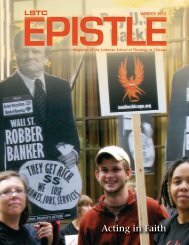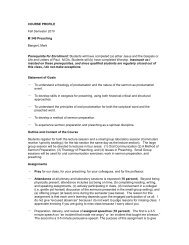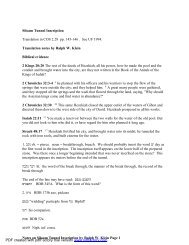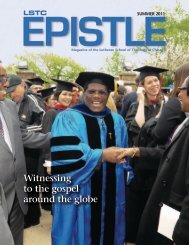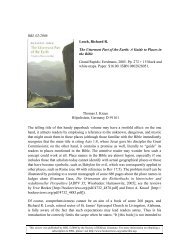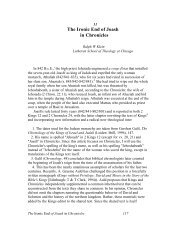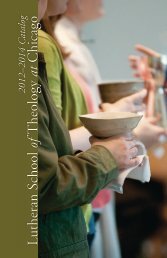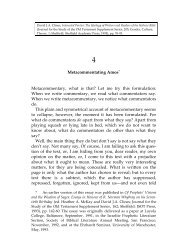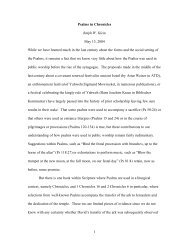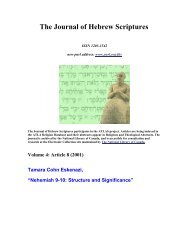Download this PDF file - University of Alberta - Journal Hosting
Download this PDF file - University of Alberta - Journal Hosting
Download this PDF file - University of Alberta - Journal Hosting
You also want an ePaper? Increase the reach of your titles
YUMPU automatically turns print PDFs into web optimized ePapers that Google loves.
“IN CONVERSATION WITH ODED LIPSCHITS” 41I submitted the Hebrew version <strong>of</strong> the manuscript to Yad YizhakBen Zvi in 2001 because it was time to do so, and even if the book wasaccepted for publication, and actually was published in April 2003, I wasnot entirely satisfied. I still saw problems and “holes” in my picture <strong>of</strong>Judah in the 6 th century BCE, and still thought some <strong>of</strong> them could andshould be filled. Thus I waited until 2004 to submit the Englishmanuscript <strong>of</strong> the book, trying meanwhile to solidify the biblicalanalyses in it, along with the historical discussions and demographicevaluations. I worked on these revisions especially during my Sabbaticalyear in Heidelberg as a visiting scholar in the Wissenschaftlich-Theologisches Seminar <strong>of</strong> the Ruprecht Karls Universität. 29 Some <strong>of</strong>my new thoughts and conclusions were also published in papersbetween 2001 and 2004. 30 The overall picture was then presented in theEnglish edition <strong>of</strong> the book, even though I choose to end the book witha series <strong>of</strong> questions and subjects that remain open. Some <strong>of</strong> themshould be the subject <strong>of</strong> further research and some <strong>of</strong> them shouldprobably wait for future developments and future finds.When I started to prepare my research for publication, with themain goal <strong>of</strong> presenting a synthetic overview <strong>of</strong> the history <strong>of</strong> Judahunder Babylonian rule, I knew that I would have two options: to focuson the half empty cup; or to focus on the half full cup. To focus on thehalf empty cup would necessitate demonstrating the gaps in ourknowledge, emphasizing caution in treating archaeological and historicalproblems and probably avoiding an overall synthesis. To focus on thehalf full cup would mean taking full cognizance <strong>of</strong> the gaps in ourknowledge while treating in an exhaustive way each <strong>of</strong> the differentfields <strong>of</strong> research: biblical, archaeological and historical. My goal was tostudy each <strong>of</strong> them independently, without interference from the otherfields, but with a clear purpose: to get to a point where a positivesummary could be <strong>of</strong>fered, and then a synthesis. Of course it is possiblethat I misunderstood some details or that I misinterpreted others.Naturally future discoveries can change our knowledge and perspectivesconcerning some parts in <strong>this</strong> big puzzle, and thus how we reconstructJerusalem (1999), 115-123 (Hebrew); “Judah, Jerusalem and the Temple (586-539 B.C.),” Transeuphratène 22 (2001), 129-142; “The Policy <strong>of</strong> the PersianEmpire and the Meager Architectural Finds in the Province <strong>of</strong> Yehud,” Faust,A. and Baruch, E. (eds.). New Studies in Jerusalem (Proceedings <strong>of</strong> the SeventhConference) (Ramat-Gan, 2001), 45-76 (Hebrew); “Was There a Royal Estatein Ein-Gedi by the End <strong>of</strong> the Iron Age and During the Persian Period?,”Schwartz, J., Amar, Z. and Ziffer, I. (eds.) Jerusalem and Eretz Israel (Arie KindlerVolume; Tel-Aviv, 2000), 31-42 (Hebrew).29 During <strong>this</strong> year I was hosted by my good friend and colleague, Pr<strong>of</strong>.Manfred Oeming, and I would like to thank him for it.30 See Lipschits, O. Demographic Changes in Judah between the 7 th and the5 th Centuries BCE., Lipschits, O. and Blenkinsopp, J. (eds.) Judah and the Judeansin the Neo-Babylonian Period. (Winona Lake, Ind.: Eisenbrauns, 2003), 323-376;“Ammon in Transition from Vassal kingdom to Babylonian Province,”BASOR 335 (2004), 37-52; From Geba to Beersheba – A Further Discussion.RB 111-3 (2004), 345-361; “Achaemenid Imperial Policy, Settlement Processesin Palestine, and the Status <strong>of</strong> Jerusalem in the Middle <strong>of</strong> the Fifth CenturyBCE,” Lipschits, O. and Oeming, M. (eds.). Judah and the Judeans in the PersianPeriod. Winona-Lake, Ind.: Eisenbrauns; 2006), 19-52.



